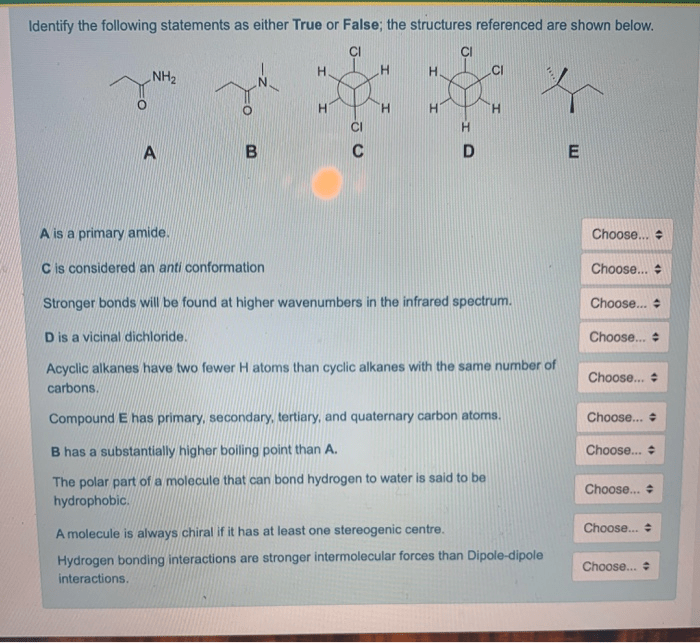Which of the following statements about collagen is true? This question delves into the intriguing world of collagen, a remarkable protein that plays a crucial role in maintaining the structural integrity and functionality of our bodies. From its unique molecular structure to its diverse applications in medicine and industry, collagen presents a fascinating subject that warrants exploration.
Collagen, the most abundant protein in mammals, is a key component of connective tissues, providing strength, elasticity, and resilience. Its intricate molecular architecture, composed of triple-helical polypeptide chains, endows it with exceptional tensile strength. Collagen’s unique amino acid composition, featuring an abundance of glycine, proline, and hydroxyproline, contributes to its stability and resistance to proteolytic degradation.
Collagen Structure
Collagen is a fibrous protein with a unique molecular structure that provides strength and flexibility to connective tissues. It consists of three polypeptide chains twisted together in a triple helix, forming a superhelix. Each chain is composed of repeating amino acids, primarily glycine, proline, and hydroxyproline.
These amino acids have specific structural roles: glycine allows for tight packing of the chains, proline provides rigidity, and hydroxyproline stabilizes the triple helix through hydrogen bonding.
Collagen Types
There are over 28 types of collagen, each with a distinct amino acid composition and structural variations. The most common types are:
- Type I:Found in skin, bone, tendon, and ligaments; provides tensile strength and support.
- Type II:Found in cartilage; provides compressive strength and flexibility.
- Type III:Found in skin, blood vessels, and internal organs; provides elasticity and support.
- Type IV:Found in basement membranes; provides a barrier and support for epithelial cells.
Collagen Properties

Tensile Strength and Elasticity
Collagen is known for its exceptional tensile strength, making it resistant to stretching. It also exhibits elasticity, allowing it to recoil to its original shape after deformation. This combination of strength and elasticity contributes to the structural integrity and resilience of connective tissues.
Tissue Flexibility and Resilience
Collagen fibers provide flexibility to tissues, allowing them to withstand bending and movement. They also contribute to tissue resilience, enabling them to recover from deformation and maintain their structural integrity.
Wound Healing and Tissue Repair
Collagen plays a crucial role in wound healing and tissue repair. It forms a temporary matrix that supports cell migration, growth, and differentiation. As the wound heals, collagen is remodeled and replaced with new tissue, restoring the structural integrity of the affected area.
Collagen Distribution: Which Of The Following Statements About Collagen Is True

Tissues and Organs
Collagen is found in almost all connective tissues throughout the body, including skin, bones, tendons, ligaments, cartilage, and blood vessels. It also provides structural support to organs such as the heart, lungs, and kidneys.
Distribution of Collagen Types
Different collagen types are distributed throughout the body based on their specific functions:
- Type I:Skin, bone, tendon, ligament
- Type II:Cartilage
- Type III:Skin, blood vessels, internal organs
- Type IV:Basement membranes
Collagen Synthesis and Degradation

Synthesis
Collagen synthesis is a complex process involving fibroblasts, specialized cells found in connective tissues. Fibroblasts secrete procollagen, which undergoes modifications, including hydroxylation and glycosylation, to form mature collagen.
Degradation
Collagen is constantly degraded and remodeled in the body by enzymes called collagenases. This process allows for the removal of damaged or old collagen fibers and the replacement with new ones.
Factors Affecting Production and Degradation
Several factors can affect collagen production and degradation, including age, hormones, nutrition, and certain diseases. As we age, collagen production decreases, while degradation increases, leading to wrinkles and reduced skin elasticity.
Collagen Applications
Medical Applications
- Tissue engineering:Collagen scaffolds are used to create artificial tissues and organs.
- Regenerative medicine:Collagen-based products promote wound healing and tissue repair.
Industrial Applications, Which of the following statements about collagen is true
- Food industry:Collagen is used as a thickening agent and stabilizer in food products.
- Cosmetics and skincare:Collagen is a popular ingredient in anti-aging creams and lotions due to its ability to improve skin elasticity and reduce wrinkles.
FAQ Explained
What is the primary function of collagen in the body?
Collagen provides structural support and tensile strength to connective tissues, maintaining the integrity of bones, skin, tendons, and ligaments.
What is the unique molecular structure of collagen?
Collagen is composed of triple-helical polypeptide chains, with a repeating amino acid sequence of glycine-proline-hydroxyproline.
How does collagen contribute to wound healing?
Collagen forms a scaffold for new tissue growth, promoting the formation of granulation tissue and the eventual healing of wounds.